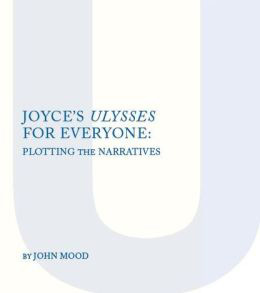
|
Joyce's Ulysses for Everyone: Plotting The Narratives
Description
Dr. Mood's study returns Joyce's masterwork to the reader (and to accessibility) by a coupling of essential narrative themes that are humorous, sexy and suspenseful developments and a plot cycle that speaks to James Joyce's abiding fascination with femininity, gender, Irish politics and the social relevance of national literature and the world of the novel. Mood re connects Joyce's use of first appearance and first occurrence to its Shakespearean origin and purpose.
Forward by Declan Kiberd
Academica Press is an independent scholarly press specializing in publishing monographs and reference material in the humanities and social sciences. We are particularly interested in producing works of scholarly interest English language studies, literary history and criticism ,drama, sociology, education and Irish studies. (Our dedicated imprint, Maunsel & Co., specializes in scholarly research in Irish studies.) We have recently developed projects in African and Afro-American research areas as well as Theology and Legal Studies.
Newly Revised & Updated Version
Paperback: 124 pages
Publisher: Academica Press (June 16, 2013)
Language: English
ISBN-10: 1936320665
ISBN-13: 978-1936320660
Product Dimensions: 8.9 x 5.9 x 0.3 inches
Price on Amazon: $39.37 & FREE Shipping.
buy now |
I first read Joyce’s Ulysses in 1965, and have read it fourteen times since, including three times out loud with my wife and five times while listening to unabridged spoken book versions. I consider it the funniest, sexiest and most exciting novel ever written. It follows the activities of its characters around Dublin on one day, Thursday, 16 June 1904. It is amazing how much can happen in one day!
But my friends, students, casual acquaintances, even total strangers, all of whom read serious novels, complained for years about not being able to get very far into Ulysses. I suggested they read it out loud. I suggested skipping the first three chapters about the young ex-Catholic Stephen Dedalus at an uncertain point in his life, starting instead with the fourth chapter where the older ex-Jewish ad salesman Leopold Bloom comes on stage, wanting to pass on wisdom to the son he had who died and also wrestling with the fact that Molly, his wife, is to begin an affair later in the day. Bloom is so much more immediately accessible, especially to non-Catholics. But nothing seemed to help these would-be readers of the novel.
It is not only the dense, almost lyrically poetic prose that seems to daunt them. It is also the incredibly complex set of allusions and grids Joyce placed over his story--the parallels with Homer’s Odyssey, the Shakespearean references (especially to Hamlet), Catholic theology (especially that of Thomas Aquinas), Dublin’s streets, Joyce’s own life, plus all the other lesser allusions. It is daunting.
Then, an unabridged taped version came out in 1995 (now on CD, as is a second version), and after I had listened/read the novel a couple more times, I slowly began to hatch a plan.
With the professionally read version of Joyce’s masterpiece in hand, one big hurdle to reading it was removed. What was also needed was a simple guide to the plots of Ulysses. For it has superb plotting, in fact, two double plots, with masterfully devised suspense, as the two stories eventually become intertwined. And as I said, this is done in prose that is funny and sexy, and breathtakingly poetic as well, especially as read by professional actors.
So I wrote this book, finding at last, after four decades, the words I wanted to say about my favorite piece of fiction. This is the revised and updated version, nine years later.
Early in the book, I expand some on the issues I have already mentioned here, but I also disassociate Ulysses from the Odyssey by listing the chapter titles I have used in my mind for years instead of the Homeric ones Joyce, and everyone else, always use. For example, instead of calling the first chapter “Telemachus,” I call it “Tower,” and instead of “Calypso” for the fourth chapter, I use “Breakfast.” This serves to remind the reader of what the chapter is really “about.”
Then, after a brief discussion of the odd dual structure of the plot and the various narrative styles of each chapter, the heart of the book is a chapter by chapter description of what happens in each and, to a lesser extent especially earlier on, the style the story is told in. I say little about all the allusions, concentrating on the plot twists and turns. If one listens to the book being read while looking at the text, and uses my guide to the story line, I think anyone interested in serious fiction can not only “get” Ulysses, but can enjoy and begin to understand it.
Additional aids are a list identifying more than 120 characters in the book (including the first page they appear on), family trees of the Dedaluses and the Blooms, and a list of recurring words and phrases Joyce uses to identify who is being spoken about, for example, “panther” for Stephen’s bad dream the night before and “Plasto’s ha” for Bloom’s hat and the card for the letter-writing affair he is carrying on.
Finally, I meet head-on the problem of the enormous secondary literature which everyone seems to think has to be read in order to enjoy and understand Ulysses. This is not essential to my purpose in my book, but would perhaps be of interest to beginning Joyce scholars. I do this by using two of my own contributions from the early ‘70s to Joycean scholarship, one, published, on politics in chapter eight of the novel, and the other on sex in Joyce, previously unpublished because my writing, like Joyce’s, is too racy. My hope is that my book will encourage readers to discover for themselves the thrills of reading Ulysses, and to assist them in enjoying this greatest of all novels.
Thank you, |


